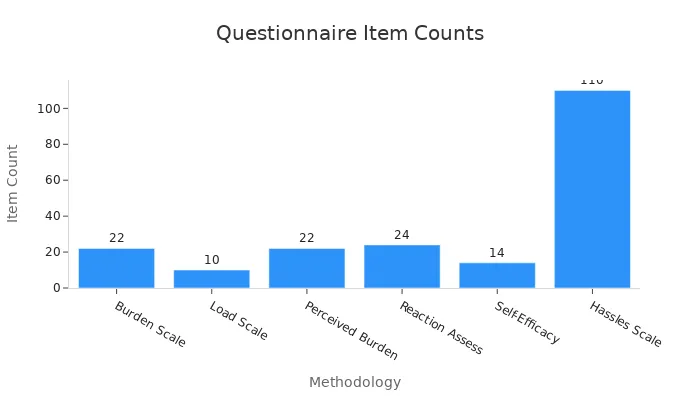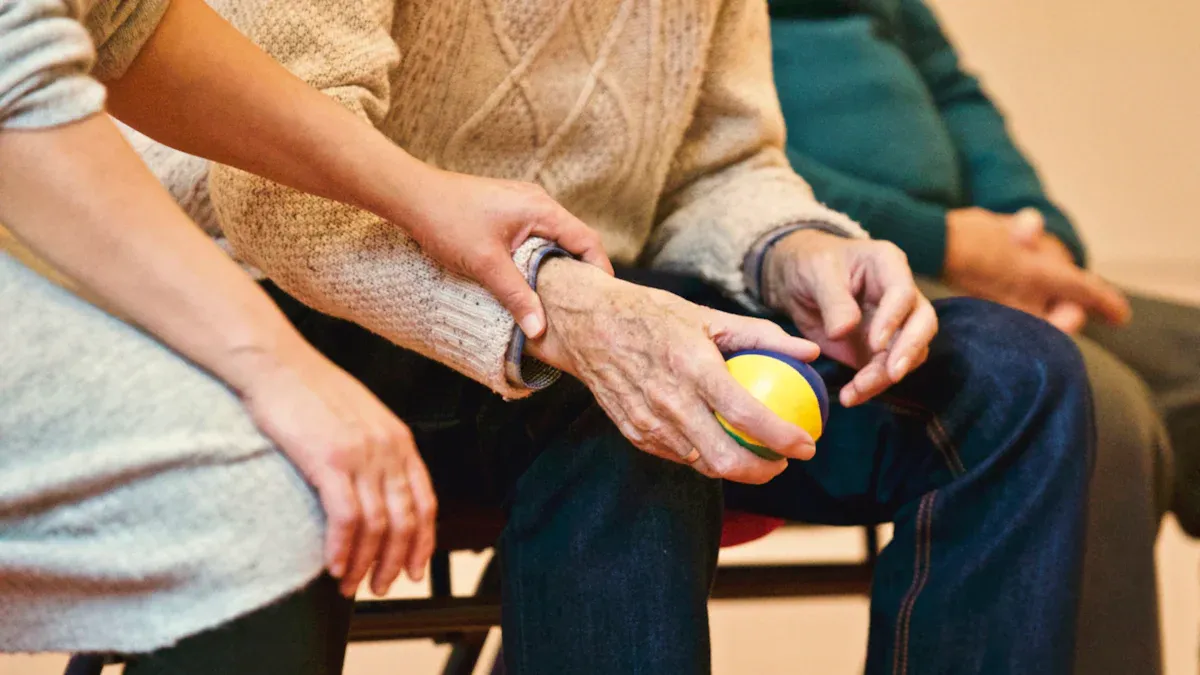10 Practical Tips for Caregivers to Set Healthy Boundaries

Caregiving can be both rewarding and overwhelming, highlighting The Importance of Setting Boundaries for Caregiver Health. You might find yourself juggling endless responsibilities, often at the expense of your own well-being. Studies show that between 40% to 70% of caregivers experience symptoms of depression, and nearly 23% report a decline in their physical health. Over time, this emotional and physical strain can take a serious toll on your life.
Setting boundaries isn’t selfish—it’s necessary. The Importance of Setting Boundaries for Caregiver Health cannot be overstated. Boundaries help you protect your energy and maintain your health, which ultimately allows you to provide better care. By recognizing your limits and prioritizing your needs, you can create a sustainable caregiving routine that benefits both you and your loved one.
Key Takeaways
Notice when you feel stressed or worn out. Watch for feeling very tired or easily annoyed. Accept these feelings to take care of yourself.
Match your caregiving limits to your personal goals. Think about what is most important to you and set rules that fit those things.
Share what you need in a clear way. Use easy words and listen carefully to help others understand and work with you.
Plan time for yourself often. Treat this time like a must-do meeting to rest and stay healthy.
Help the person you care for be more independent. Share tasks and let them do things on their own to keep caregiving fair.
The Importance of Setting Boundaries for Caregiver Health
Recognize the Signs of Stress and Burnout
Caregiving can be incredibly demanding, and it’s easy to overlook the toll it takes on your mental and physical health. But recognizing the signs of stress and burnout is the first step toward protecting yourself. Have you noticed feeling emotionally drained or unusually irritable? These could be signs that you’re pushing yourself too hard.
Clinical research highlights several measurable indicators of burnout:
Indicator | Description |
|---|---|
Emotional Exhaustion | Feeling drained and depleted emotionally, often leading to a lack of motivation. |
Cynicism | Developing a detached or negative attitude toward caregiving tasks or the care recipient. |
Inefficiency | Struggling to complete tasks or feeling like you’re not accomplishing enough. |
Anxiety | Experiencing persistent worry or unease that affects your overall well-being. |
Changes in Appetite | Noticing shifts in eating habits, like craving comfort foods or losing interest in meals altogether. |
If any of these resonate with you, it’s time to take a step back and reassess. Setting boundaries can help you regain control and prevent these symptoms from escalating.
Align Boundaries with Personal Goals
When you align your caregiving boundaries with your personal goals, you create a healthier balance for yourself. Think about what’s most important to you. Do you want to spend more time with your family? Focus on your career? Or maybe prioritize your health? By identifying your goals, you can set boundaries that reflect your values and needs.
For example, if maintaining your physical health is a priority, you might set aside time for regular exercise or meal prep. This isn’t just about saying “no” to extra tasks—it’s about saying “yes” to what matters most. Studies show that aligning boundaries with personal goals helps caregivers manage stress and build a sustainable lifestyle. It also improves the quality of care you provide because you’re operating from a place of balance and intention.
Remember, boundaries aren’t just about limiting what you do for others. They’re about creating space for what you need to thrive.
Understand and Define Your Limits
Reflect on Your Emotional and Physical Capacity
Understanding your limits starts with reflecting on what you can handle emotionally and physically. Caregiving is demanding, and pushing yourself too far can lead to burnout. Take a moment to ask yourself: How much energy do I have today? Am I feeling emotionally drained or physically exhausted? These questions can help you gauge your capacity and make adjustments before you reach your breaking point.
To get a clearer picture of your limits, consider using tools like the Caregiver Burden Scale or the Caregiver Reaction Assessment. These questionnaires measure different aspects of caregiving, such as emotional involvement, physical strain, and time demands. Here’s a quick comparison of some popular tools:
Methodology/Questionnaire | Description | Scoring Method | Domains Measured |
|---|---|---|---|
Caregiver Burden Scale, CB | Measures subjective burden | 4-point scale | General strain, isolation, disappointment |
Caregiver Reaction Assessment, CRA | Assesses family members' reactions | 5-point scale | Esteem, finances, health |
Caregiver Self-Efficacy | Evaluates self-care and problem-solving | 0-100 scale | Self-care, problem-solving |

These tools can guide you in identifying areas where you may need to set boundaries. They’re not just for professionals—they’re for you, too.
Identify Non-Negotiables in Your Caregiving Role
Once you understand your capacity, it’s time to define your non-negotiables. These are the things you absolutely need to protect your well-being. For example, maybe you need eight hours of sleep or a quiet hour each morning to recharge. Write these down and treat them as priorities.
Non-negotiables also apply to your caregiving tasks. Are there certain responsibilities you can’t compromise on, like attending medical appointments or managing medications? By identifying these, you can focus your energy on what truly matters and delegate or decline other tasks.
Remember, setting boundaries around your non-negotiables isn’t selfish. It’s a way to ensure you’re providing the best care possible while maintaining your own health. After all, The Importance of Setting Boundaries for Caregiver Health lies in creating a sustainable balance for both you and your loved one.
Communicate Your Needs Effectively
Use Clear and Respectful Language
Expressing your needs clearly and respectfully can make a big difference in your caregiving journey. When you communicate effectively, you reduce misunderstandings and foster cooperation. Start by focusing on how you deliver your message. Using simple and direct language ensures that others understand you without confusion. For example, instead of saying, "I’m overwhelmed," try, "I need help with preparing meals this week."
Active listening is another essential part of respectful communication. Pay attention to non-verbal cues, like body language and tone, to better understand the emotions behind someone’s words. This approach helps you respond with empathy and patience.
Here are some evidence-based strategies to improve your communication:
Active listening: Focus on the other person’s emotions and non-verbal cues.
Clear and simple language: Speak slowly and avoid overly complex words.
Calm demeanor: Stay patient and composed, even during stressful conversations.
Non-verbal communication: Use gestures, facial expressions, and eye contact to show care.
The PC4 Model emphasizes person-centered communication, where caregivers and care recipients are treated as unique individuals. This model encourages empathetic practices, active listening, and open-ended questions to enhance understanding and collaboration.
By adopting these strategies, you create a supportive environment where everyone feels heard and valued.
Share Your Limits with Others
Once you’ve defined your boundaries, it’s important to share them with the people around you. Openly discussing your limits helps set expectations and prevents misunderstandings. For example, if you’ve decided to reserve evenings for personal time, let others know in advance. You might say, "I’m available to help during the day, but I need my evenings free to recharge."
When sharing your limits, focus on collaboration rather than confrontation. Frame your boundaries as a way to ensure you can continue providing care without burning out. This approach helps others see the value of your boundaries, rather than viewing them as restrictions.
It’s also helpful to involve others in problem-solving. If you can’t handle a particular task, ask for input on how to delegate it. For instance, you could say, "I’m unable to take on grocery shopping this week. Can someone else step in, or should we consider delivery services?" This invites others to contribute while respecting your limits.
Remember, sharing your boundaries isn’t just about protecting your well-being. It’s also about improving the quality of care you provide. After all, The Importance of Setting Boundaries for Caregiver Health benefits everyone involved.
Manage Guilt and Negative Emotions
Reframe Guilt as a Sign of Care
Feeling guilty is common for caregivers. You might think you’re not doing enough or worry about taking time for yourself. But here’s the thing—guilt often shows how much you care. It reflects your genuine desire to provide the best for your loved one. Instead of letting guilt weigh you down, try reframing it as a sign of your compassion.
Recognizing and accepting your feelings is the first step. It’s okay to feel guilty sometimes, but don’t let it control you. Set realistic expectations for yourself. You’re only human, and no one can do it all. Focus on quality over quantity. Spending meaningful time with your loved one matters more than being available 24/7.
Tip: Celebrate small wins. Did you help your loved one smile today? That’s a success worth acknowledging.
Mindfulness can also help. Practices like meditation or deep breathing can ease guilt and bring clarity. When you take care of yourself, you’re better equipped to care for others. Remember, setting boundaries isn’t about neglecting your loved one—it’s about ensuring you can continue to support them in the long run.
Focus on the Benefits of Boundaries for Everyone
Boundaries aren’t just good for you—they benefit everyone involved. When you set clear limits, you create a healthier caregiving dynamic. Your loved one knows what to expect, and you avoid overextending yourself. This balance fosters mutual respect and understanding.
Guilt can sometimes mask deeper fears, like the worry of letting someone down. By deconstructing these emotions, you can uncover what’s really driving them. Practicing radical acceptance helps you embrace your role without feeling overwhelmed. It’s not about doing everything; it’s about doing what you can, with care and intention.
Note: Boundaries allow you to focus on what truly matters. They help you prioritize your energy and improve the quality of care you provide.
When you reframe guilt and set boundaries, you create a more positive caregiving experience. You’ll feel less stressed, and your loved one will benefit from your renewed energy and focus. It’s a win-win for everyone.
Schedule Time for Yourself

Create a Balanced Routine
Taking care of yourself is just as important as caring for someone else. A balanced routine helps you stay energized and focused. Start by carving out time for activities that recharge you, like exercise, hobbies, or simply relaxing with a book. Think of this as an investment in your well-being.
Research shows that caregivers who schedule regular breaks—ideally every 90 minutes—maintain better health and energy levels. These breaks prevent burnout and improve your ability to provide quality care. You might feel like there’s no time for yourself, but even short pauses can make a big difference.
To create a balanced routine, consider using evidence-based planning methods. Here’s a quick guide to help you get started:
Method | Description |
|---|---|
Mindfulness and Relaxation | Strategies to reduce stress and promote relaxation. |
Self-Care Planning | A personalized plan to prioritize rest, hobbies, and social connections. |
Boundary Setting | Establishing healthy boundaries to protect energy and well-being. |
Resilience Building | Tools to cope with challenges while maintaining emotional strength. |
Cognitive Behavioral Therapy | Helps manage thoughts and behaviors contributing to stress, anxiety, or depression. |
Acceptance and Commitment Therapy | Embraces experiences and reduces emotional struggle while aligning actions with personal values. |
Pick one or two methods that resonate with you and start small. Over time, you’ll find a rhythm that works for your unique situation.
Stick to Your Personal Time Commitments
Once you’ve set aside time for yourself, honor it. Treat your personal time like an appointment you can’t miss. It’s easy to let caregiving tasks creep into your schedule, but sticking to your commitments ensures you don’t lose sight of your own needs.
Think of this as a promise to yourself. If you’ve planned a 30-minute walk or a coffee break with a friend, don’t cancel it unless absolutely necessary. These moments recharge you and help you show up as your best self.
You might face resistance from others—or even yourself—but remember why this matters. Taking care of yourself isn’t selfish. It’s essential for your health and the quality of care you provide.
Tip: Use reminders or alarms to keep track of your personal time. This helps you stay consistent and prevents you from overcommitting.
By creating a balanced routine and sticking to it, you’ll feel more in control and less overwhelmed. You deserve this time, and your loved one will benefit from a happier, healthier you.
Encourage Independence in the Care Recipient
Delegate Tasks to Others
You don’t have to do everything yourself. Delegating tasks is a great way to lighten your load while encouraging your care recipient to rely on others. It’s not about passing off responsibilities—it’s about creating a team that supports both you and your loved one.
Start by identifying tasks that others can handle. For example, family members or friends might help with grocery shopping, meal prep, or transportation. Professional caregivers, like home care aides (HCAs), can also take on more complex tasks. These might include dressing, wound care, or medication management. Studies show that involving HCAs in these roles not only improves the quality of care but also promotes the independence of care recipients. With proper training and supervision, this approach ensures safety while enhancing their quality of life.
When you delegate, be clear about what needs to be done. Provide instructions and set expectations. This helps everyone feel confident and capable. You’ll find that sharing responsibilities creates a more balanced caregiving experience for everyone involved.
Tip: Don’t hesitate to ask for help. People often want to support you—they just need to know how.
Support Their Autonomy and Growth
Encouraging independence means giving your loved one opportunities to do things on their own. Even small tasks, like choosing their clothes or preparing a simple meal, can boost their confidence. It’s about focusing on what they can do, not what they can’t.
You can also introduce tools or resources that make daily activities easier. Adaptive utensils, grab bars, or mobility aids can empower them to take charge of their routine. Celebrate their efforts, no matter how small. Positive reinforcement builds their self-esteem and motivates them to keep trying.
Note: Supporting autonomy doesn’t mean stepping back completely. Be there to guide and encourage, but let them take the lead when possible.
By fostering independence, you’re helping your loved one grow and thrive. It’s a gift that benefits both of you in the long run.
Build a Support Network

Reach Out to Family, Friends, or Professionals
You don’t have to do this alone. Reaching out to family, friends, or professionals can make a world of difference in your caregiving journey. Many caregivers rely on their social networks for help, with 70% turning to family and friends for support. This shows how vital it is to lean on those around you when things get tough.
Start by identifying people who can assist with specific tasks. Maybe a sibling can help with transportation, or a neighbor can run errands. Don’t hesitate to ask for help—it’s not a sign of weakness but a way to share the load. You might say, “Could you help with grocery shopping this week?” Clear and direct requests make it easier for others to step in.
Professionals can also provide valuable support. Home care aides, therapists, or financial advisors can address specific challenges, from managing medical needs to navigating financial strain. Did you know that 66% of caregivers struggle to find adequate resources? Professionals can bridge that gap, reducing stress and improving your well-being.
Tip: Use online tools to research local services. Caregivers with Internet access are 84% more likely to find helpful resources than those without.
Join Caregiver Support Groups for Emotional Backup
Sometimes, you just need someone who truly understands what you’re going through. That’s where caregiver support groups come in. These groups connect you with others facing similar challenges, offering a safe space to share experiences and advice.
Programs like the Chronic Disease Self-Management Program (CDSMP) have proven benefits. Participants report better emotional health, fewer days of depression, and an improved quality of life. The shared experiences in these groups foster a sense of community, reminding you that you’re not alone.
Note: Community programs also reduce isolation and stress, which are common struggles for caregivers.
Joining a support group can be as simple as attending a local meeting or joining an online forum. These connections can provide the emotional backup you need to keep going strong.
Leverage Tools and Resources
Explore Local Services and Programs
You don’t have to navigate caregiving alone. Local services and programs can provide valuable support, helping you manage your responsibilities more effectively. Many communities offer resources tailored to caregivers, such as workshops, respite care, and wellness programs. These services not only lighten your load but also improve the quality of care your loved one receives.
For example, programs like Chronic Disease Self-Management and A Matter of Balance have shown remarkable benefits. They enhance your loved one’s health while reducing your stress. Here’s a quick look at some popular programs and their advantages:
Program Name | Benefits | Cost Savings per Participant |
|---|---|---|
Chronic Disease Self-Management | Improves self-reported health, reduces depression, enhances quality of life | $364 |
A Matter of Balance | Reduces fear of falling, encourages exercise | $938 |
Stepping On | 30% reduction in falls, fosters confidence and independence | $134 |
These programs not only save money but also empower you and your loved one to live healthier, more independent lives. Many caregivers report high satisfaction with these services, which can also reduce feelings of isolation.
Tip: Check with local community centers, hospitals, or caregiver organizations to find programs near you.
Use Technology to Simplify Caregiving Tasks
Technology can be a game-changer for caregivers. From managing schedules to tracking expenses, the right tools can make your life easier and more organized. Studies show that 77% of caregivers save time by using technology, while 74% feel less stressed.
Many apps and platforms are designed specifically for caregiving. Features like shift management, secure communication, and care plan reviews keep everything running smoothly. Here’s a breakdown of what some tools offer:
Feature | Description |
|---|---|
Shift Management | View and manage shifts/schedules |
Time Tracking | Clock in and out easily |
Document Access | Access important paperwork |
Secure Communication | Send HIPAA-compliant messages |
Expense Documentation | Track mileage and caregiving-related costs |
Note: Even simple tools like medication reminders or grocery delivery apps can make a big difference.
By exploring these resources, you’ll not only save time but also feel more confident in your caregiving role. Technology and local programs are here to support you—take advantage of them!
Practice Self-Care Consistently
Prioritize Physical Health Through Exercise and Nutrition
Taking care of your physical health is one of the best ways to stay strong and energized as a caregiver. Regular exercise and balanced nutrition don’t just benefit your body—they also boost your mental well-being. Even small changes can make a big difference.
Here’s why prioritizing physical health matters:
Regular physical activity reduces caregiver burden and improves overall well-being.
Exercise helps lower anxiety and depression, giving you a clearer mind to handle daily challenges.
The World Health Organization highlights self-care strategies like physical activity as essential for maintaining your health and quality of life.
You don’t need to spend hours at the gym to see results. A brisk 20-minute walk, yoga stretches, or even dancing to your favorite music can get your heart pumping. Pair this with a nutritious diet rich in fruits, vegetables, and lean proteins to fuel your body. Think of it as giving yourself the energy to care for others.
Tip: Start small. Swap sugary snacks for healthier options or add a quick workout to your morning routine. These little steps add up over time.
Nurture Emotional Well-Being with Mindfulness or Hobbies
Your emotional health is just as important as your physical health. Caregiving can feel overwhelming, but nurturing your emotional well-being helps you stay balanced and resilient. Mindfulness practices and hobbies are powerful tools to achieve this.
Research shows that mindfulness meditation and engaging in hobbies build resilience against burnout. These activities enhance your sense of purpose and help you maintain emotional balance. Whether it’s gardening, painting, or simply sitting quietly with your thoughts, these moments of self-care recharge your spirit.
Mindfulness doesn’t have to be complicated. Start with a few minutes of deep breathing or focus on the present moment while sipping your coffee. Hobbies, on the other hand, allow you to express yourself and find joy outside of caregiving.
Note: Taking time for yourself isn’t selfish—it’s necessary. When you care for your emotional well-being, you’re better equipped to support your loved one.
By prioritizing both your physical and emotional health, you create a foundation for sustainable caregiving. You deserve to feel good, too.
Learn to Say No with Confidence
Recognize When to Decline Requests
Saying no can feel uncomfortable, especially when you’re used to putting others first. But knowing when to decline requests is essential for protecting your time and energy. Start by asking yourself a few questions: Does this task align with your priorities? Will taking it on leave you feeling overwhelmed or resentful? If the answer is yes, it’s time to set a boundary.
You don’t have to justify your decision with long explanations. A simple, polite response works best. For example, you could say, “I’m sorry, but I can’t take that on right now.” This approach is clear and respectful, leaving little room for misunderstanding.
It’s also helpful to recognize patterns. Are there certain people or situations that consistently push your limits? Identifying these triggers can help you prepare and respond more confidently in the future. Remember, saying no isn’t about being unkind—it’s about ensuring you have the capacity to care for yourself and others effectively.
Tip: Practice saying no in low-pressure situations. This builds your confidence for when it really matters.
Offer Alternatives to Maintain Relationships
Saying no doesn’t mean shutting people out. You can maintain strong relationships by offering alternatives that work for both parties. For instance, if you can’t help with a specific task, suggest another way to support them.
Here are a few ideas:
Encourage independence in the person you’re caring for.
Seek help from family members or professionals when needed.
For example, if someone asks you to run an errand, you might say, “I can’t do that today, but I can help you find a delivery service.” This shows you care while still respecting your boundaries.
By offering alternatives, you create a win-win situation. You protect your well-being while showing others that their needs still matter. It’s all about balance and mutual respect.
Setting boundaries isn’t just about protecting your energy—it’s about creating a caregiving experience that works for you and your loved one. When you prioritize self-care, you reduce stress and avoid burnout. Nearly 40% to 70% of caregivers report symptoms of depression, showing how vital it is to take care of yourself.
Start small. Choose one tip from this list and put it into practice today. Whether it’s scheduling time for yourself or saying no with confidence, every step matters. Remember, self-care isn’t a luxury—it’s the foundation of sustainable caregiving. You deserve it.
FAQ
What are healthy boundaries in caregiving?
Healthy boundaries are limits you set to protect your time, energy, and well-being. They help you balance caregiving with your personal needs. For example, deciding when you're available to help or what tasks you can handle ensures you don’t overextend yourself.
How do I explain my boundaries without upsetting others?
Use clear and respectful language. Focus on your needs and how boundaries improve your caregiving. For example, say, “I need evenings to recharge so I can provide better care during the day.” This frames boundaries as beneficial for everyone.
What if I feel guilty about setting boundaries?
Guilt is normal, but it often shows how much you care. Reframe it as a sign of your compassion. Remember, boundaries help you stay healthy, which benefits both you and your loved one. Self-care isn’t selfish—it’s necessary.
How can I stick to my boundaries when others push back?
Stay firm but kind. Politely remind others of your limits. For example, say, “I understand this is important, but I can’t take on more right now.” Offering alternatives, like suggesting someone else who can help, keeps the conversation constructive.
Are there tools to help me manage caregiving tasks?
Yes! Apps like CareZone or Lotsa Helping Hands simplify caregiving. They help with scheduling, medication tracking, and task delegation. Technology can save time and reduce stress, making your caregiving role more manageable.
See Also
Join Us at Banish Cancer – A Place of Hope
Choroid Plexus Carcinoma: Key Symptoms and Treatment Options
An In-Depth Overview of Various Cancer Types
Conjunctival Melanoma: Recognizing Symptoms and Available Treatments
Basal Cell Carcinoma: Identifying Symptoms and Key Information
